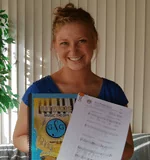RCM Intermediate Rudiments Exam – FREE Practice Exam with 10 Tips
Are you preparing for the RCM Intermediate Rudiments Exam? The Ultimate Music Theory FREE Practice Exam will show you the Way to Score Success!
 In preparing for the RCM Intermediate Rudiments Exam, begin with the FREE Practice Exam.
In preparing for the RCM Intermediate Rudiments Exam, begin with the FREE Practice Exam.
Here are 10 Tips for successful completion of the RCM Intermediate Rudiments Exam.
These 10 UMT Tips are included in the FREE Practice Exam.
Theory Tips are essential for building knowledge and confidence.
The Ultimate Music Theory Exam Series includes UMT Tips. SEE inside the Intermediate Rudiments Exam Set #1 Workbook HERE.
READ the UMT Tips before completing each question in the Free Practice Exam. Good Luck with your RCM Intermediate Rudiments Exam!
Download FREE Practice Intermediate Rudiments Exam
In order to view the FREE Practice Exam as a PDF file get the latest version of the Adobe Reader here.
TOP 10 Tips for RCM Intermediate Rudiments Exam Preparation
- RCM Intermediate Rudiments Exam – UMT Tip #1
Before beginning your exam, write out the Circle of Fifths. Write the order of flats and sharps. Write the Major keys on the outside of the circle and the relative minor keys on the inside of the circle.
BONUS UMT Tip
When writing intervals: Intervals can be inverted by moving the upper (top) note down an octave or by moving the lower (bottom) note up an octave.
- RCM Intermediate Rudiments Exam – UMT Tip #2
When writing triads: In close position, notes are written as close together as possible. The distance between two notes cannot be larger than a 4th.
BONUS UMT Tip
When writing triads: In open position, notes are spread out. The distance between two notes can be larger than a 4th. Notes can also be doubled.
- RCM Intermediate Rudiments Exam – UMT Tip #3
When transposing a melody: First write the Clef, the new Key Signature, the Time Signature and all bar lines.
BONUS UMT Tip
When rewriting a melody using a Key Signature: Name the accidentals in order of the Key Signature. When accidentals are in the correct Key Signature order, the key is usually Major. Missing or additional accidentals usually indicate a minor Key Signature.
- RCM Intermediate Rudiments Exam – UMT Tip #4
When writing a scale using accidentals and a bar line, all accidents must be repeated after the bar line.
- RCM Intermediate Rudiments Exam – UMT Tip #5
When naming the key and type of cadence: Identify the notes in the Bass Clef as the Tonic, Subdominant or Dominant. Identify if the Key Signature is for the Major key or the relative minor key.
- RCM Intermediate Rudiments Exam – UMT Tip #6
When naming the key of an excerpt: An accidental is often used on the raised Leading note of the minor key. However an accidental may also simply be an accidental used to enhance the music.
- RCM Intermediate Rudiments Exam – UMT Tip #7
When adding rests to complete a measure: Identify if the Time Signature is Simple Time or Compound Time. A dotted rest will only be used in Compound Time.
- RCM Intermediate Rudiments Exam – UMT Tip #8
When naming a blues, chromatic, Major pentatonic, minor pentatonic, octatonic or whole tone scale: Count the number of notes in the scale to identify the possible choices.
- RCM Intermediate Rudiments Exam – UMT Tip #9
When matching musical terms with English definitions: First identify the terms that you know. Then try to match the terms that you are not sure of. There will be extra definitions that will not be used.
- RCM Intermediate Rudiments Exam – UMT Tip #10
When analyzing a piece of music: A slur connects notes of different pitches and indicates to play smoothly (legato). A tie connects notes of the same pitch and indicates to hold for the combined value of both notes.
Prepare for the RCM Intermediate Rudiments Exam with the Ultimate Music Theory Exam Series.
Ultimate Music Theory – The Way to Score Success!
